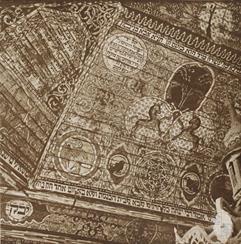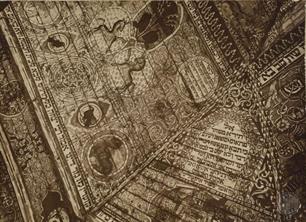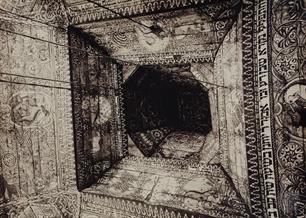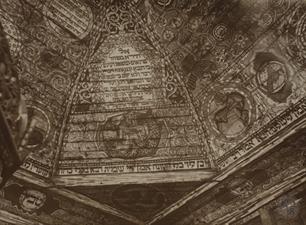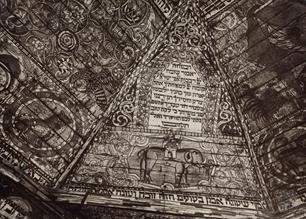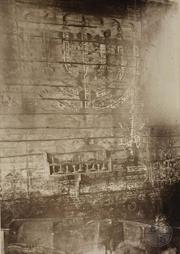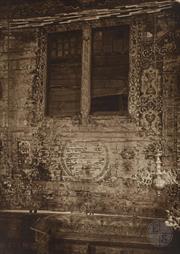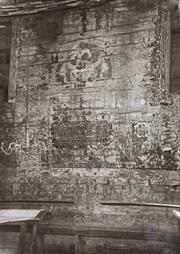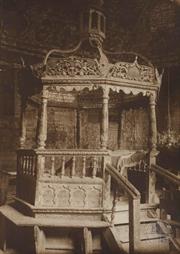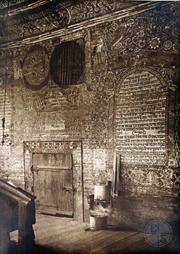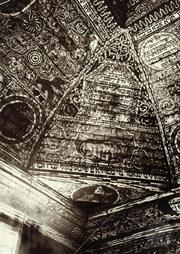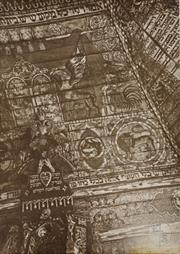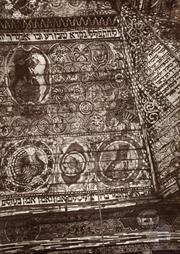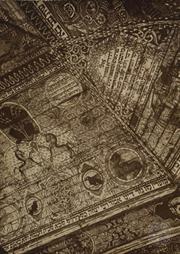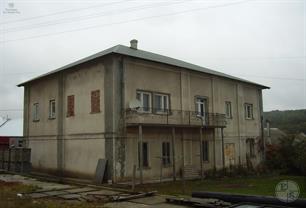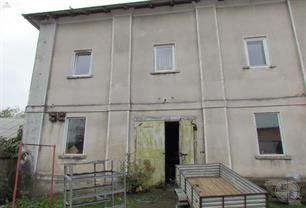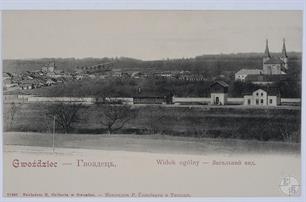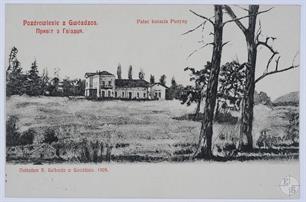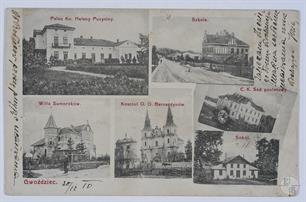Hvizdets
Sources:
- Pinkas Hakehillot Polin: Encyclopedia of Jewish Communities, Poland, Volume II, pp. 135–137., published by Yad Vashem, Jerusalem.
- Russian Jewish encyclopedia
- Jewish encyclopedia of Brockhaus & Efron
- Virtual Shtetl. Gwoździec
- Kruglov A. Dean M., “Gwoździec,” [in:] Encyclopedia of Camps and Ghettos 1939–1945, vol. 2, Ghettos in German-Occupied Eastern Europe, eds. P. Megargee, M. Dean, Bloomington 2012, p. 779.
Photo:
- Alois Breyer, Vladimir Levin. Published by Center for Jewish art
- Biblioteka Narodowa Polona. Gwoździec
- Pinkas Hakehillot Polin: Encyclopedia of Jewish Communities, Poland, Volume II, pp. 135–137., published by Yad Vashem, Jerusalem.
- Russian Jewish encyclopedia
- Jewish encyclopedia of Brockhaus & Efron
- Virtual Shtetl. Gwoździec
- Kruglov A. Dean M., “Gwoździec,” [in:] Encyclopedia of Camps and Ghettos 1939–1945, vol. 2, Ghettos in German-Occupied Eastern Europe, eds. P. Megargee, M. Dean, Bloomington 2012, p. 779.
Photo:
- Alois Breyer, Vladimir Levin. Published by Center for Jewish art
- Biblioteka Narodowa Polona. Gwoździec
Kolomyya district, Ivano-Frankivsk region
In 1908, a local branch of the Mizrachi was established. The same year saw the foundation of the “Safa Brura” Hebrew school, attended by 95 pupils.
Since 1891 until the end of the 19th century, there were two rabbis working concomitantly in the town – Josef ben Jehoshua Friedman, who held the post until 1934, and Israel Matiyach ben Nachman Zeev Auerbach. Following the death of Rabbi Auerbach, his son Nachman Zeev Auerbach assumed his duties.
The community life continued to thrive in the interwar period, although Jews started to experience more and more economic hardships due to the foundation and development of the Ukrainian co-operative movement, running independent stores and warehouses.
In 1921, Gwoździec had 1,234 Jewish residents.
The years 1923–1924 saw the establishment of the Jewish Association of Primary Schools (Igud ha-yehudei le-betei sefer ammiyim), running courses on the Hebrew language and general subjects.
In 1925, local supporters of Poale Zion opened a two-grade school with Yiddish as the language of instruction, which was virtually unheard of in the eastern parts of former Galicia.
A branch of Hashomer Hatzair was established in Gwoździec in 1927; it had gained 80 members by 1935.
The town also boasted cells of such prominent groups as Betar or Bnei Akiva, as well as a branch of the Women’s International Zionist Organisation (WIZO; est. 1935).
The “Dror” Sports Association was active in the town in the years 1931–1939; its football section enjoyed great popularity. The Bund founded the “Patish” (“Hammer”) sports club.
In 1935, an unusually turbulent election was held to appoint the new rabbi. Voters could choose between two candidates. A large crowd gathered at the Jewish school, and soon a scuffle broke out between the supporters of the two competitors. The election was eventually won by Jakub Leiter, who held the post of the rabbi in Gwoździec until the Holocaust. He died in the Bełżec death camp in 1942.
A branch of the Joint was established in Gwoździec as early as 1927. In the years 1934–1935, the organisation provided local Jews with financial assistance at a total value of 9,482 zlotys. The subsidies helped Jews deal with the growing Ukrainian competition in trade.
In 1937, new regulations on ritual slaughter were introduced. As a result, only four kosher butchers remained in Gwoździec.
One of the expressions of anti-Semitic sentiments in Gwoździec was a smear campaign launched against travelling salesmen.
In 1937, a Jewish pedlar was assaulted, while his son wounded one of the attackers with a knife. A threat of riots started to loom over the town, but it was eventually prevented thanks to an intervention of the police.
In 1935, Gwoździec had a population of 3,314, including 2,331 Jews. During the last election to the Jewish community council held in 1939, Zionists received 52 votes, the list of “Eretz Israel H’Ovedet” – 50 votes, and the Mizrachi – only six votes.
Throughout the interwar period, Jews continued to work in trade and crafts. However, the Jewish intelligentsia started to emerge – in the years 1918–1939, there were two doctors and three lawyers in Gwoździec. Six families dealing with agriculture lived in the suburbs of the town (41 people in total). Jewish farmers grew their crops on a shared plot of land; they also raised horses and cattle.
Since 1891 until the end of the 19th century, there were two rabbis working concomitantly in the town – Josef ben Jehoshua Friedman, who held the post until 1934, and Israel Matiyach ben Nachman Zeev Auerbach. Following the death of Rabbi Auerbach, his son Nachman Zeev Auerbach assumed his duties.
The community life continued to thrive in the interwar period, although Jews started to experience more and more economic hardships due to the foundation and development of the Ukrainian co-operative movement, running independent stores and warehouses.
In 1921, Gwoździec had 1,234 Jewish residents.
The years 1923–1924 saw the establishment of the Jewish Association of Primary Schools (Igud ha-yehudei le-betei sefer ammiyim), running courses on the Hebrew language and general subjects.
In 1925, local supporters of Poale Zion opened a two-grade school with Yiddish as the language of instruction, which was virtually unheard of in the eastern parts of former Galicia.
A branch of Hashomer Hatzair was established in Gwoździec in 1927; it had gained 80 members by 1935.
The town also boasted cells of such prominent groups as Betar or Bnei Akiva, as well as a branch of the Women’s International Zionist Organisation (WIZO; est. 1935).
The “Dror” Sports Association was active in the town in the years 1931–1939; its football section enjoyed great popularity. The Bund founded the “Patish” (“Hammer”) sports club.
In 1935, an unusually turbulent election was held to appoint the new rabbi. Voters could choose between two candidates. A large crowd gathered at the Jewish school, and soon a scuffle broke out between the supporters of the two competitors. The election was eventually won by Jakub Leiter, who held the post of the rabbi in Gwoździec until the Holocaust. He died in the Bełżec death camp in 1942.
A branch of the Joint was established in Gwoździec as early as 1927. In the years 1934–1935, the organisation provided local Jews with financial assistance at a total value of 9,482 zlotys. The subsidies helped Jews deal with the growing Ukrainian competition in trade.
In 1937, new regulations on ritual slaughter were introduced. As a result, only four kosher butchers remained in Gwoździec.
One of the expressions of anti-Semitic sentiments in Gwoździec was a smear campaign launched against travelling salesmen.
In 1937, a Jewish pedlar was assaulted, while his son wounded one of the attackers with a knife. A threat of riots started to loom over the town, but it was eventually prevented thanks to an intervention of the police.
In 1935, Gwoździec had a population of 3,314, including 2,331 Jews. During the last election to the Jewish community council held in 1939, Zionists received 52 votes, the list of “Eretz Israel H’Ovedet” – 50 votes, and the Mizrachi – only six votes.
Throughout the interwar period, Jews continued to work in trade and crafts. However, the Jewish intelligentsia started to emerge – in the years 1918–1939, there were two doctors and three lawyers in Gwoździec. Six families dealing with agriculture lived in the suburbs of the town (41 people in total). Jewish farmers grew their crops on a shared plot of land; they also raised horses and cattle.
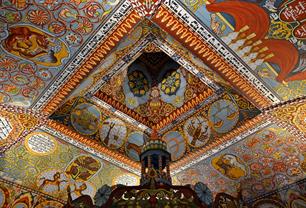 |
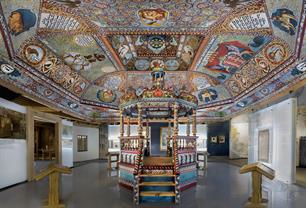 |
| Reproduction of the painting of the dome of synagogue in the Museum of the History of Jews in Warsaw | An attempt was also made to restore the appearance of Bima |
The art painting of the walls and the dome was made in 1652 by Israel Ben Mordechai Lisnitsky from Yaryshiv. After the damage, the painting was restored in 1729 by Isaac Ben Iehuda Ha-Kohen from Yaryshiv.
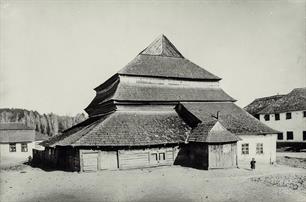 |
 |
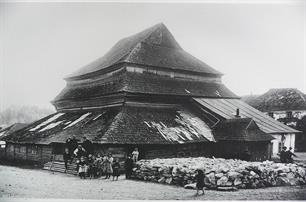 |
| Wooden synagogue in Hvizdeys | It was destroyed in time World War 2 | Children in front of the synagogue |
In September 1939, Gwoździec and the entire Stanisławowskie Province came under Soviet occupation. The changes in the political system undercut the economic foundations of the Jewish community, destroying the local trade and private crafts. All political activities were prohibited. However, Jews did not experience ethnic persecution. They found employment in nationalised factories and local administrative bodies.
On 2 June 1941, the town was seized by Hungarian troops allied with Germany. Jews were sent to work at the local airport and in the fields, but the Hungarians protected them from Ukrainians. During the Hungarian occupation, a Judenrat was formed in Gwoździec, headed first by Grinberg and later by Elisz Zannenzуw.
The predicament of the Jewish population changed dramatically in November 1941, when Hungarians were replaced by Germans. All Jews were ordered to wear armbands. The occupying forces established a unit of the Jewish police.
A ghetto was set up in the eastern part of Gwoździec, near the railway station, at the turn of 1942. Its population reached 1,540 people, including Jews deported from nearby Kołomyja (Kolomyya). The relocation process was carried out in great haste, leaving most people no time to pack up their belongings. Imprisoned in a cramped space and starved, the Jews were forced to perform slave labour. Efforts were made to obtain food by bartering with peasants from nearby villages, but supplies were becoming more and more difficult to come by.
In mid-March 1942, the news of deportations and acts of genocide in nearby localities started to reach Gwoździec. Some people started to prepare hideouts.
On 12 April 1942, soon after Passover, the perimeter of the ghetto was surrounded by Germans and Ukrainians. Jews were rushed out of their houses. Some buildings were set on fire, probably in order to force out those still in hiding. Several hundred Jews, mostly the weak and unable to stand, were driven to the nearby forest and shot.
The people who survived the eight-hour terror (mostly workesr employed outside the ghetto) were forced to collect the bodies and incinerate them.
On 24 April 1942, a group of 311 Jews was rushed on foot to the ghetto in Kołomyja. They were allowed to take up to 15 kg of luggage. Knowing that they would face starvation in the ghetto, they packed as much food as possible.
The ghetto in Gwoździec was liquidated on 8 September 1942, several days before Rosh Hashanah.
The last surviving prisoners were deported to ghettoes in larger cities. It can be assumed that Jews from Gwoździec were included in the transport of 4,000 people sent from Kołomyja to the death camp in Bełżec on 11 September 1942.
A small group of people went into hiding with the help of local peasants and lived to see the arrival of the Red Army on 28 March 1944. Among the Jews who returned to the town there were also people who survived the Holocaust in the USSR. However, the Jewish community was never revived.
After 1945, only one Jew lived in Gwoździec – Yaakov Leibovich Gayer (b. 4 November 1905, d. 25 April 1987), who had served in the Red Army during the war.
On 2 June 1941, the town was seized by Hungarian troops allied with Germany. Jews were sent to work at the local airport and in the fields, but the Hungarians protected them from Ukrainians. During the Hungarian occupation, a Judenrat was formed in Gwoździec, headed first by Grinberg and later by Elisz Zannenzуw.
The predicament of the Jewish population changed dramatically in November 1941, when Hungarians were replaced by Germans. All Jews were ordered to wear armbands. The occupying forces established a unit of the Jewish police.
A ghetto was set up in the eastern part of Gwoździec, near the railway station, at the turn of 1942. Its population reached 1,540 people, including Jews deported from nearby Kołomyja (Kolomyya). The relocation process was carried out in great haste, leaving most people no time to pack up their belongings. Imprisoned in a cramped space and starved, the Jews were forced to perform slave labour. Efforts were made to obtain food by bartering with peasants from nearby villages, but supplies were becoming more and more difficult to come by.
In mid-March 1942, the news of deportations and acts of genocide in nearby localities started to reach Gwoździec. Some people started to prepare hideouts.
On 12 April 1942, soon after Passover, the perimeter of the ghetto was surrounded by Germans and Ukrainians. Jews were rushed out of their houses. Some buildings were set on fire, probably in order to force out those still in hiding. Several hundred Jews, mostly the weak and unable to stand, were driven to the nearby forest and shot.
The people who survived the eight-hour terror (mostly workesr employed outside the ghetto) were forced to collect the bodies and incinerate them.
On 24 April 1942, a group of 311 Jews was rushed on foot to the ghetto in Kołomyja. They were allowed to take up to 15 kg of luggage. Knowing that they would face starvation in the ghetto, they packed as much food as possible.
The ghetto in Gwoździec was liquidated on 8 September 1942, several days before Rosh Hashanah.
The last surviving prisoners were deported to ghettoes in larger cities. It can be assumed that Jews from Gwoździec were included in the transport of 4,000 people sent from Kołomyja to the death camp in Bełżec on 11 September 1942.
A small group of people went into hiding with the help of local peasants and lived to see the arrival of the Red Army on 28 March 1944. Among the Jews who returned to the town there were also people who survived the Holocaust in the USSR. However, the Jewish community was never revived.
After 1945, only one Jew lived in Gwoździec – Yaakov Leibovich Gayer (b. 4 November 1905, d. 25 April 1987), who had served in the Red Army during the war.
The history of the Jewish presence in Gwoździec (now Hvizdets) reaches back to the 16th century. In 1557, a private city was founded at the site, drawing significant income from organising fairs and markets. The earliest sources to mention Jews living in Gwoździec date back to 1635.
In 1640, a famous synagogue was erected in Gwoździec, one of the most beautiful in the Polish territories. Its stood out thanks to its double hip roof, later copied in the design of other synagogues, and splendid polychromatic paintings created by “the master of sacred works,” Israel ben Mordechai Liśniecki (Lissnitzki) from Yarychiv (painted ca. 1652).
In 1765, 541 Jews lived in Gwoździec, constituting 60% of the total population. They mostly earned a living from trade, crafts, and innkeeping, while most Christians living in the suburbs were farmers. In the 19th and the 20th century, Jews also started to work as pedlars selling their wares in nearby towns. An important figure in the 18th-century community was Rabbi Icchak ben Abraham Schur, a man reportedly “strong as an ox.” He headed the community until his death in 1777.
In 1880, Gwoździec had a population of 1,887, including 1,263 Jews. In 1900, there were 1,683 Jews among a total of 2,422 inhabitants. Throughout the entire 19th century, the local community was dominated by the Hasidim. The first “cracks” in the strictly conservative character of the community started to appear at the end of the century.
In 1892, the Baron Hirsch School was opened in the town; it existed until 1914. The same period saw the emergence of the Zionist movement in Gwoździec; a library and drama club were founded at the beginning of the 20th century.
In 1640, a famous synagogue was erected in Gwoździec, one of the most beautiful in the Polish territories. Its stood out thanks to its double hip roof, later copied in the design of other synagogues, and splendid polychromatic paintings created by “the master of sacred works,” Israel ben Mordechai Liśniecki (Lissnitzki) from Yarychiv (painted ca. 1652).
In 1765, 541 Jews lived in Gwoździec, constituting 60% of the total population. They mostly earned a living from trade, crafts, and innkeeping, while most Christians living in the suburbs were farmers. In the 19th and the 20th century, Jews also started to work as pedlars selling their wares in nearby towns. An important figure in the 18th-century community was Rabbi Icchak ben Abraham Schur, a man reportedly “strong as an ox.” He headed the community until his death in 1777.
In 1880, Gwoździec had a population of 1,887, including 1,263 Jews. In 1900, there were 1,683 Jews among a total of 2,422 inhabitants. Throughout the entire 19th century, the local community was dominated by the Hasidim. The first “cracks” in the strictly conservative character of the community started to appear at the end of the century.
In 1892, the Baron Hirsch School was opened in the town; it existed until 1914. The same period saw the emergence of the Zionist movement in Gwoździec; a library and drama club were founded at the beginning of the 20th century.

- Home
- Shtetls
- Vinnytsia region
- Volyn region
- Dnipro region
- Donetsk region
- Zhytomyr region
- Zakarpattia region
- Zaporizhzhia region
- Ivano-Frankivsk region
- Kyiv region
- Kropyvnytskyi region
- Luhansk region
- Lviv region
- Mykolayiv region
- Odessa region
- Poltava region
- Rivne region
- Sumy region
- Ternopil region
- Kharkiv region
- Kherson region
- Khmelnytskyi region
- Chernihiv region
- Chernivtsi region
- Cherkasy region
- Crimea
- Synagogues
- Cemeteries
- Objects & guides
- Old photos
- History
- Contact
Jewish towns of Ukraine
Jewish towns of Ukraine
My shtetl
My shtetl
Donate
